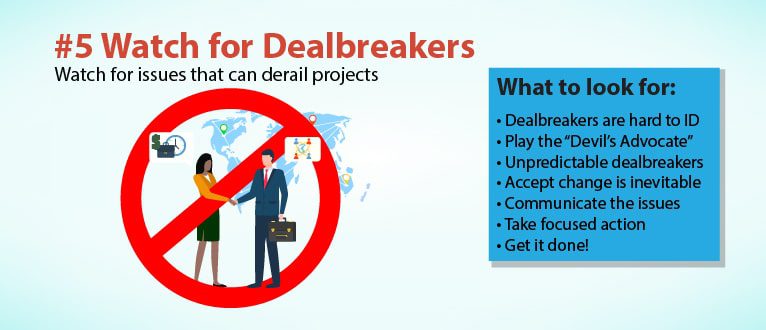#5 in the new Blog Series: How to Evaluate Legal Operations Solutions
Evaluating Legal Ops Solutions: Fifth, Watch for Dealbreakers
Now that you’ve created your evaluation team, asked the right questions, determined the actual needs, and set achievable goals, it’s time to identify and avoid any potential dealbreakers that could make your project “crash on the rocks,” wiping out all your team’s hard work.
Dealbreakers are issues that cause failures… of any kind. These issues may emerge at any point during the evaluation journey – usually at the worst possible moments. Not only that, dealbreakers may change as you move through the process. For that reason, it’s essential to train everyone on the team to watch for dealbreakers by staying alert to deal with unseen obstacles that could negatively affect the outcome. Team members can see things around them that you might not. This approach gives you the greatest opportunity for your project to remain on course towards a winning outcome.

Be aware: Dealbreakers are often hard to identify
Dealbreakers mean different things to different people, which makes them harder to pinpoint. Keep in mind that:
- We’re not talking about hurdles or problems
- These are issues that can cause project failure – at any stage
- These issues may crop up at any time and could remain in a constant state of change.
Ninja Tip: The good news is that, with your entire team focused on staying alert during ongoing changes, you have more eyes on the target – allowing any barriers to be identified and addressed far more quickly. Keep a list of dealbreakers as they are found and use as a checklist for your team to handle. The team will watch for dealbreakers and train themselves to identify them quickly.
Play the “Devil’s Advocate”
Watch for dealbreakers from a number of different perspectives. This allows an overview of the issue rather than focusing on a symptom. Ask probing questions like, “Why is that needed?,” “What happens if the budget doesn’t support what we need to do?,” and “If this helps only Legal and not my department, is it a win for the company?”
Next steps:
- Take a realistic view of all possible or probable issues
- At each point, ask yourself, “What do we do if this happens?”
Ninja Tip: Schedule regular meetings with your team and assign a different person to take on the role of Devil’s Advocate each time. Allow the others to brainstorm the response. This activity gives you insights into the team and possible solutions to issues.
Remember that dealbreakers can be unpredictable
They can come from anywhere and be based on anything, including:
- Loss of funding
- Environmental conditions
- Personal or professional biases
- Time constraints.
Ninja Tip: Expect the unexpected. Simple to say, but the team must be ready to handle budget cuts, unforeseen lack of executive support, competitive challenges, market changes, etc. These are often out of the team’s control and managed by others. Keep in mind that changes may derail the project or other company goals may take priority.
Accept the fact that change is inevitable
Given that change – including competitive and market changes — are a likelihood, you can take steps to deal with it before it becomes a dealbreaker. Change doesn’t have to necessarily create problems if you keep the right perspective. It can lead to an opportunity to add valuable data points to the evaluation or address a need to change the scope to guarantee success:
- Anticipate changes
- Plan contingencies
- Be proactive, not reactive.
Ninja Tip: Recognize changes happen. Deal with them as they come and stay away from thinking that everything is a dealbreaker. Prioritize when possible, deal with it as it comes, and be active when changes occur.
Communicate!
Once you’ve identified any impediment to your success, it’s time to stop and communicate with your legal department team members and others involved in the evaluation process.
Communicate to:
- Evaluate the underlying issue
- Make sure it can be overcome
- Get on top of it quickly.
Ninja Tip: There is no greater skill to build than the ability to communicate effectively. Evaluating solutions requires the ability to identify the right challenges to resolve and then communicate that to the team. When a dealbreaker exists, communicate it quickly and start working on a solution together.
Take focused actions
Dealbreakers will not necessarily deter you if you act thoughtfully and immediately:
- Deploy contingency plans to attack the issue head-on
- Watch for morale changes – you need champions, not nay-sayers on the team
- Be honest and encouraging, distrust can spell disaster.
Ninja Tip: When you take action, make sure it’s working towards the project goal. Dealbreakers can cause confusion and often lead to rash actions. Focus on why the dealbreaker happened and take corrective, swift actions.
Get it done!
You’ve faced it head-on. Now you need to evaluate whether success is possible
- Bring teams together with the main stakeholders
- Communicate both the issues and the planned fixes
- Ensure the cost of success is acceptable to the business.
Ninja Tip: Dealbreakers are not all doom and gloom from the onset. If possible, simply fix them and move on. If any one of them turns out to be a true dealbreaker that will cause the project to fail, record the reasons and what led up to the dealbreaker to learn from the experience gained.
Keep your team focused on pressing forward until further notice. Dealbreakers can change too. Stay focused and watch for dealbreakers to help drive the project’s success. By taking steps to identify dealbreakers along the way, your team will have opportunities to grow their problem-solving skills from a deeper experience in solution evaluations.
Next steps: Gathering Evidence
Now it’s time to focus on examining each solution to ensure that it lives up to the marketing hype the providers are giving you. Much like a district attorney building a case, you need to gather objective, hands-on evidence. Seeing it in action will often tell more than reading a lot of literature, not to mention that it takes less time.
This is critical. Without seeing the User Interface (UI), understanding how it can integrate into your existing workflow, and checking the inputs and outputs, how can you agree to install the solution?
We’ll cover the types of evidence and how to use them to build your case in selecting the best Legal Ops solution for your entire organization.
While every company’s checklist will vary, yours should look something like this:
- Assemble the team (Read this post)
Start a conversation with leaders in every business unit that touches yours, and, if appropriate, invite them to be part of your evaluation team. - Ask incisive questions (Read this post)
Get to the heart of the business issue and identify a quantifiable goal. - Evaluate the need (Read this post)
Consider whether the need is great enough to commit your collective resources. - Set goals (Read this post)
Look at quantifiable goals for short-term (now through the next year) and longer-term (through the next 3-5 years) time periods. Make them measurable. - Watch for dealbreakers (You’re reading this post)
Discuss what, if anything, would jeopardize a decision. - Gather evidence
Encourage members who are not part of your own unit to share challenges they face in theirs and what they’re doing to overcome them. - Follow best practices
It’s quite possible that examples of what other teams have done will include a formal or informal list of best practices – or at least some insights for creating that list.





